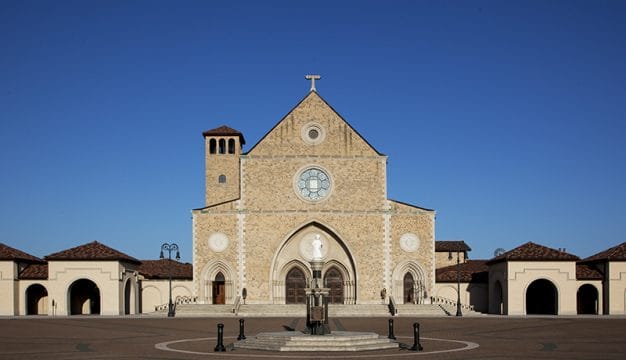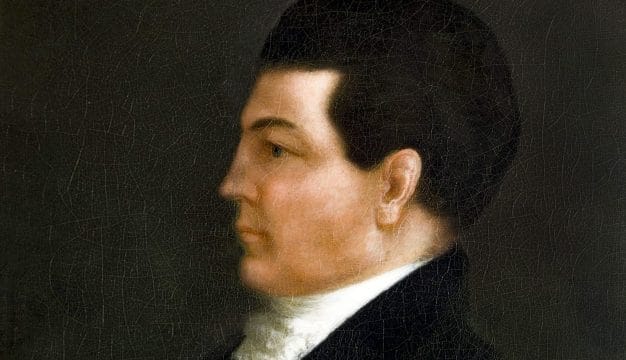André Pénigaut
André Pénigaut (1680-?) is credited with being Alabama’s first literary figure for his vivid accounts of the French exploration and settlement of what today includes Mobile, the Mississippi Gulf Coast, and Louisiana. His name is also variously spelled as Penicaut, Pénigault, and Pérricault. What historians know of his life derives almost entirely from his journals, entitled Annals of Louisiana from 1698 to 1722. The work remains one of the main sources of information on Native American life, geography and ecology, and historical events during the colonial period in the Gulf Coast region.
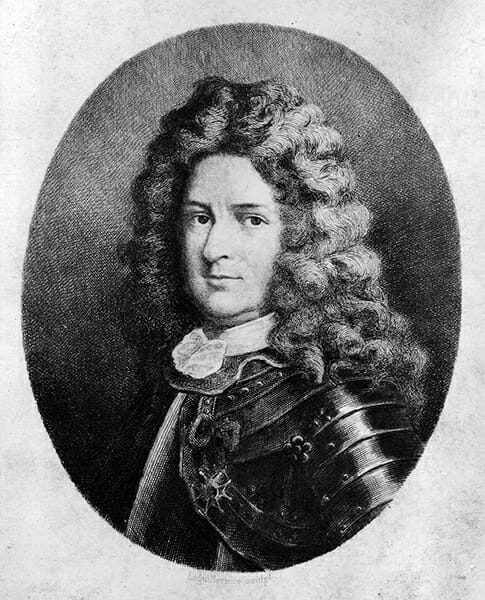 Pierre Le Moyne d’Iberville
Pénigaut was born in La Rochelle, a city on the west coast of France, about 1680. The date and location of his death are unknown. Trained as a ship’s carpenter, Pénigaut signed a deed of indenture to accompany Pierre Le Moyne, Sieur d’Iberville (known as Iberville), on his expedition to the French province of La Louisiane (as the French holdings in what is now North America were then known) in 1699. Eighteen years old at the time, Pénigaut had been exposed to the world of ships and nautical travel in his port-city hometown. Pénigaut was assigned to building and repairing ships and began keeping a detailed journal around this time. For the next two decades, he travelled with Iberville and his brother Jean Baptiste Le Moyne d’Bienville (known as Bienville) as they explored the region from Mobile Bay west to present-day Louisiana and into Spanish territory in what is now Texas. He returned to France in 1721, after losing his eyesight, and compiled his journals into a manuscript that was first published in France in 1883 in volume five of Pierre Margry’s Découvertes et établissements des francais dans l’ouest et dans le sud l’amerique septentrionale. It was also published in several other translations, with McWilliams’ 1953 annotated edition, Fleur de Lys and Calumet, being the most authoritative version. Most historians have questioned the reliability of the timeline in Pénigaut’s journals (much of which he assembled from memory), but they continue to value his observations of the events he recorded.
Pierre Le Moyne d’Iberville
Pénigaut was born in La Rochelle, a city on the west coast of France, about 1680. The date and location of his death are unknown. Trained as a ship’s carpenter, Pénigaut signed a deed of indenture to accompany Pierre Le Moyne, Sieur d’Iberville (known as Iberville), on his expedition to the French province of La Louisiane (as the French holdings in what is now North America were then known) in 1699. Eighteen years old at the time, Pénigaut had been exposed to the world of ships and nautical travel in his port-city hometown. Pénigaut was assigned to building and repairing ships and began keeping a detailed journal around this time. For the next two decades, he travelled with Iberville and his brother Jean Baptiste Le Moyne d’Bienville (known as Bienville) as they explored the region from Mobile Bay west to present-day Louisiana and into Spanish territory in what is now Texas. He returned to France in 1721, after losing his eyesight, and compiled his journals into a manuscript that was first published in France in 1883 in volume five of Pierre Margry’s Découvertes et établissements des francais dans l’ouest et dans le sud l’amerique septentrionale. It was also published in several other translations, with McWilliams’ 1953 annotated edition, Fleur de Lys and Calumet, being the most authoritative version. Most historians have questioned the reliability of the timeline in Pénigaut’s journals (much of which he assembled from memory), but they continue to value his observations of the events he recorded.
French Explorations
 Dauphin Island Map
Iberville’s expedition aimed to find the mouth of the Mississippi River and establish a permanent French settlement there as a bulwark against the growing English stronghold in North America. On January 31, 1699, the French anchored five ships off Mobile Point and explored a small barrier island several days later. There, they discovered a large pile of human bones, so many that Pénigaut’s wrote that they “formed a mountain.” For the next several decades, the island was commonly referred to by the French colonists as “Massacre Island.” It was officially named Île Dauphin around 1711 in honor of Marie-Adélaide de Savoye, Dauphine of France, and it is now known as Dauphin Island.
Dauphin Island Map
Iberville’s expedition aimed to find the mouth of the Mississippi River and establish a permanent French settlement there as a bulwark against the growing English stronghold in North America. On January 31, 1699, the French anchored five ships off Mobile Point and explored a small barrier island several days later. There, they discovered a large pile of human bones, so many that Pénigaut’s wrote that they “formed a mountain.” For the next several decades, the island was commonly referred to by the French colonists as “Massacre Island.” It was officially named Île Dauphin around 1711 in honor of Marie-Adélaide de Savoye, Dauphine of France, and it is now known as Dauphin Island.
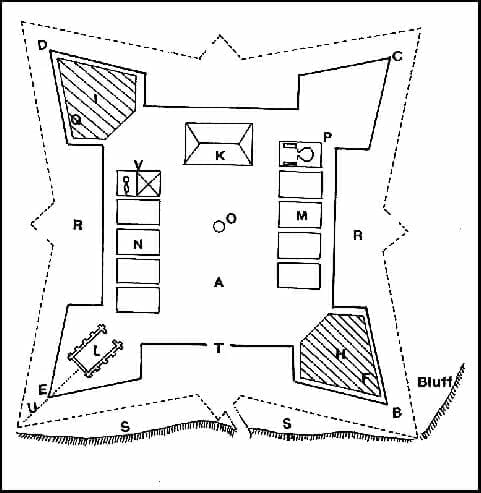 Fort Maurepas Diagram
The expedition then moved west among the small islands off what is now the Mississippi coast. Upon landing, the crew immediately began work on a fort, named Maurepas for Louis Phélypeaux, comte de Maurepas, the secretary of the French Navy at that time. Also known as Old Biloxi, the settlement would become the seat of power in French Louisiana. The French soldiers (mainly Canadians) at the fort made first contact with Native Americans from the local Biloxi nation, and Pénigaut noted in his journal that they were fascinated with the pale skin of the ship’s crew. His writing evokes the Renaissance sense of wonder and romance in its flowery style, providing support for the claim that he is Alabama’s first literary figure. With Fort Maurepas completed, Iberville returned to France, leaving Bienville in command to continue the search for the mouth of the Mississippi River. A group including Bienville and Pénigaut soon came upon a large lake in what is now Louisiana, which they named Lake Pontchartrain, also for Louis Phélypeaux, who had been granted the additional title of comte de Pontchartrain in 1699. From the lake, they were able to find an entrance to the mighty river itself and travel downstream to its mouth on March 2, 1699.
Fort Maurepas Diagram
The expedition then moved west among the small islands off what is now the Mississippi coast. Upon landing, the crew immediately began work on a fort, named Maurepas for Louis Phélypeaux, comte de Maurepas, the secretary of the French Navy at that time. Also known as Old Biloxi, the settlement would become the seat of power in French Louisiana. The French soldiers (mainly Canadians) at the fort made first contact with Native Americans from the local Biloxi nation, and Pénigaut noted in his journal that they were fascinated with the pale skin of the ship’s crew. His writing evokes the Renaissance sense of wonder and romance in its flowery style, providing support for the claim that he is Alabama’s first literary figure. With Fort Maurepas completed, Iberville returned to France, leaving Bienville in command to continue the search for the mouth of the Mississippi River. A group including Bienville and Pénigaut soon came upon a large lake in what is now Louisiana, which they named Lake Pontchartrain, also for Louis Phélypeaux, who had been granted the additional title of comte de Pontchartrain in 1699. From the lake, they were able to find an entrance to the mighty river itself and travel downstream to its mouth on March 2, 1699.
 Fort Toulouse
By the time Iberville returned the next spring, he had determined that neither Biloxi Bay nor the Mississippi River would serve as a suitable location to protect French interests on the coast or to repel incursions from England’s colonies on the eastern seaboard. Mobile Bay, with its access to the interior via an extensive river system, offered a much better location. At a site on the Mobile River recommended by the local Indians, Iberville launched construction of Fort Louis de la Louisiane in 1702 at a site that would become known as Old Mobile, or Twenty-seven Mile Bluff, overlooking the river; it would be the first permanent French settlement in Alabama. A historical marker off U.S. Highway 43 identifies the site today. Persistent flooding and a desire to relocate closer to the Gulf of Mexico led Bienville to move the entire settlement in 1711 to the site where downtown Mobile exists today. Although Pénigaut provides more extensive descriptions of the Mobile forts and settlements, he also documented the establishment of Fort Toulouse, Natchez, Natchitoches, and New Orleans. Pénigaut recorded Iberville and Bienville’s explorations of the Mobile, Tensaw, Alabama, and Tombigbee Rivers in Alabama; the Red River in Louisiana; the Yazoo River in Mississippi; and the Mississippi itself as far upstream as Illinois. He also claimed to have travelled overland as far west as the Rio Grande River in Texas with another French-Canadian explorer, Louis Juchereau de St. Denis, who had sailed with Iberville to Louisiana. Some historians are skeptical of this claim, however, because of its omissions and distortions.
Fort Toulouse
By the time Iberville returned the next spring, he had determined that neither Biloxi Bay nor the Mississippi River would serve as a suitable location to protect French interests on the coast or to repel incursions from England’s colonies on the eastern seaboard. Mobile Bay, with its access to the interior via an extensive river system, offered a much better location. At a site on the Mobile River recommended by the local Indians, Iberville launched construction of Fort Louis de la Louisiane in 1702 at a site that would become known as Old Mobile, or Twenty-seven Mile Bluff, overlooking the river; it would be the first permanent French settlement in Alabama. A historical marker off U.S. Highway 43 identifies the site today. Persistent flooding and a desire to relocate closer to the Gulf of Mexico led Bienville to move the entire settlement in 1711 to the site where downtown Mobile exists today. Although Pénigaut provides more extensive descriptions of the Mobile forts and settlements, he also documented the establishment of Fort Toulouse, Natchez, Natchitoches, and New Orleans. Pénigaut recorded Iberville and Bienville’s explorations of the Mobile, Tensaw, Alabama, and Tombigbee Rivers in Alabama; the Red River in Louisiana; the Yazoo River in Mississippi; and the Mississippi itself as far upstream as Illinois. He also claimed to have travelled overland as far west as the Rio Grande River in Texas with another French-Canadian explorer, Louis Juchereau de St. Denis, who had sailed with Iberville to Louisiana. Some historians are skeptical of this claim, however, because of its omissions and distortions.
Pénigaut’s Annals
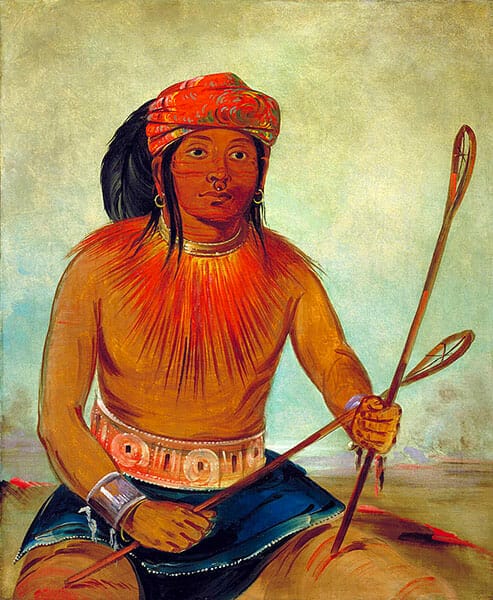 Choctaw Stickball Player
Pénigaut’s Annals are a rich source of documentation on plant and animal species of the region and their uses. He mentions a variety of plants, including native hardwoods, peaches and plums brought to North America by Europeans in the early seventeenth century, melons, cultivated grains such as maize, and the wild native grass called river or giant cane. Animal descriptions include mammals such as bears, buffaloes, wild cats, and deer; birds such as parrots, eagles, herons, wild geese (called bustards); and insects such as mosquitoes. Pénigaut’s descriptions of the region’s Native American tribes comprise arguably the most important facet of his journals. He learned to speak Mobilian Jargon, a pidgin language composed of several of the region’s Muskogean dialects that was used for trading among many tribes, and he became well-acquainted with the nations living near the French fortifications. These included the Alabamas, Mobilians, Taensas, Apalachees, and Choctaws, among many others.
Choctaw Stickball Player
Pénigaut’s Annals are a rich source of documentation on plant and animal species of the region and their uses. He mentions a variety of plants, including native hardwoods, peaches and plums brought to North America by Europeans in the early seventeenth century, melons, cultivated grains such as maize, and the wild native grass called river or giant cane. Animal descriptions include mammals such as bears, buffaloes, wild cats, and deer; birds such as parrots, eagles, herons, wild geese (called bustards); and insects such as mosquitoes. Pénigaut’s descriptions of the region’s Native American tribes comprise arguably the most important facet of his journals. He learned to speak Mobilian Jargon, a pidgin language composed of several of the region’s Muskogean dialects that was used for trading among many tribes, and he became well-acquainted with the nations living near the French fortifications. These included the Alabamas, Mobilians, Taensas, Apalachees, and Choctaws, among many others.
Detailed observations of Indian dress, foodways, family structures, hunting, fishing, warfare, and a variety of ceremonies are found throughout the Annals. For example, he describes a delicious type of bread that local Native Americans made from a reed similar to oats found along the riverbanks. Pénigaut notes that they also used this grain in a soup called sagamité, which included corn, beans, and meat, and was popular among the French as well.
Pénigaut devoted considerable space to the people of the Natchez nation, providing detailed descriptions of their food, clothing, shelters, and especially their ceremonial life. In relating the funeral of the Grand Noble Female Chief of the Natchez, Pénigaut displayed his literary bent toward the emotional or dramatic. He depicted, in florid language, the ceremonial execution of numerous babies and adults who had been selected, at the time of their own births, to die along with members of the royal family. Given his interest in documenting the significant events he witnessed, and consistent with European portraits of “warlike” Native Americans (always referred to in the journals as “savages”), Pénigaut cited several incidents of intertribal warfare as well as skirmishes with the French. He took pains, however, to commend the tribes allied with the French and to highlight the frequent ritual known as a three-day sing of the calumet (“peace-pipe”) diplomatic ceremonies.
Pénigaut’s Annals also recount (though perhaps not based on his own firsthand observations) the exploits of St. Denis and his interactions with Native Americans and the Spanish, including his journey to the Rio Grande, his sojourn, his later imprisonment in Mexico City for violating Spanish trade restrictions, his romance with the daughter of a Spanish captain there, and his founding of Natchitoches—the oldest town in present-day Louisiana—in 1715. And he extensively catalogued the land concessions granted to various French colonists, in this section and others demonstrating a remarkable ability to accurately measure distances and areas, yet another of his many valuable contributions to knowledge of the Gulf Coast.
Pénigaut’s importance to Alabama history and letters is clear. Historians of the colonial era have looked to his journals as a source for many details of Gulf Coast and Alabama exploration and settlement. And despite the consensus among them that the chronology of events was drawn from Pénigaut’s memory and therefore likely unreliable, their publications consistently include references to the journals. With Richebourg McWilliams’s 1953 translation came a greater appreciation for Pénigaut’s writing as an embodiment of “first encounter” literature in the Renaissance tradition. Thus André Pénigaut should be considered not only “Alabama’s first literary figure” but also an important source for understanding the colonial era in North America.
Further Reading
- Hamilton, Peter J. Colonial Mobile. Tuscaloosa: University of Alabama Press, 1910.
- McWilliams, Richebourg Gaillard. Fleur de Lys and Calumet: Being the Narrative of French Adventure in Louisiana. Tuscaloosa: University of Alabama Press, 1953.
- ———. “Penicaut as Alabama’s First Literary Figure.” Alabama Review 5 (January 1952): 40-60.
- Thomason, Michael, ed. Mobile: The New History of Alabama’s First City. Tuscaloosa: University of Alabama Press. 2001.

